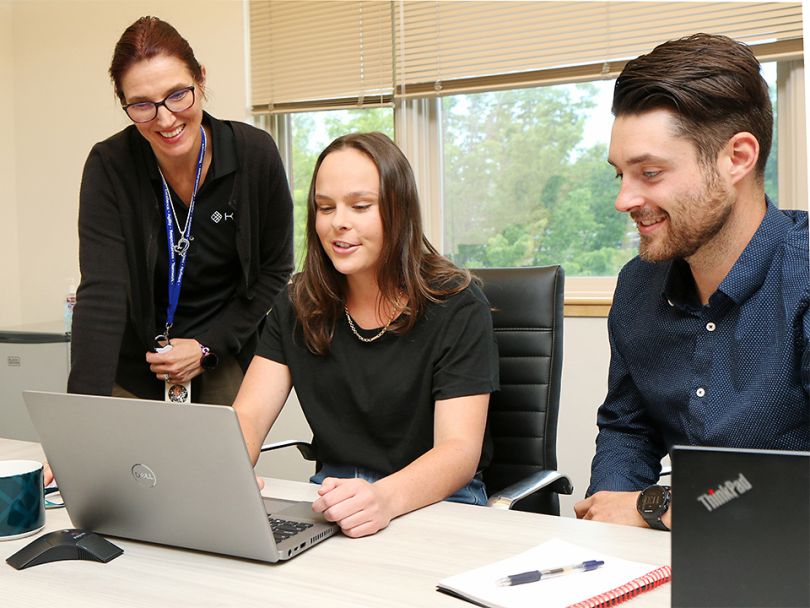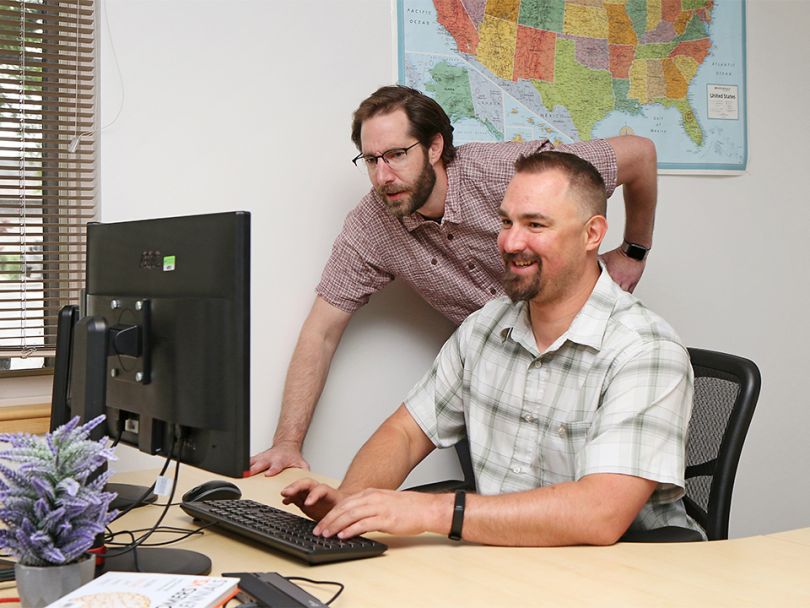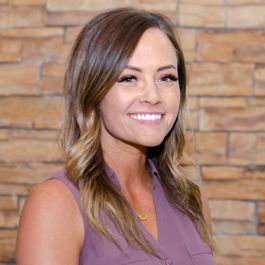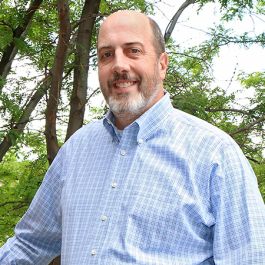There’s a widely shared reason why so many team members at KPA stick around as long as they do.
“It’s because our business makes the world a better place,” said Product Director Jade Brainard, a KPA employee herself since 2007. Of course, she added that working in environmental, health and safety compliance isn’t easy. “The regulatory landscape of EHS is ever-evolving, especially with climate change and new rules, like publicly reporting your CO2 footprint and emissions.”
It turns out that the company’s long-standing presence in the compliance industry is a direct result of the connected, collaborative team operating a complicated system behind the scenes. If KPA were to eliminate these cooperative, cross-functional processes from their operations or product development cycles, Chief Technology Officer Scott Schell said, “It wouldn’t work.”
Instead, the team relies heavily on what does work: mutual trust and teamwork — both on existing products and upcoming releases. “There’s obvious confidence on either side of any department about each other’s ability to execute on a project,” said Brainard. “Sales and marketing has confidence in R&D and product that we will deliver what we say we’re going to deliver, when we’re going to deliver it. And by the same token, R&D has confidence that sales and marketing will execute on that.”
Every step of the way, KPA relies on its interconnected team to produce the best possible product. There’s an agreement that to shape, produce and continuously develop the best possible product, it takes everyone. It’s something Chief Marketing Officer Abe Cohen hasn’t seen everywhere in his experience.
“Having trust that other departments are going to execute with high quality is a really good feeling,” he said. “It starts with good communication, collaboration and holding each other accountable.”
Together, KPA’s team is doing everything they can to make the world not only a better place, but a safer, healthier and more environmentally-conscious one. In conversation with Built In, Brainard, Schell and Cohen sat down to explore what the collaborative process unlocks for both the products and people at KPA.
Why is cross-team collaboration so important?
Schell: I’ve been part of R&D organizations that were built in silos. You had leaders at the top who, rather than rolling up their sleeves and working together, would prefer to point fingers. At KPA, there’s really no opportunity for that. We’re all in the same meetings together; we’re working on the same projects. There are no hidden agendas. If you’re communicating and collaborating often, there are no surprises.
Cohen: Having product, marketing and sales in alignment — which requires good, consistent internal communication — is critical to success. When it comes to Scott and Jade’s agile process and bringing innovations to market, my team has to be able to communicate to both our clients and the market via press and prospect communications. That all starts with tight, long-term planning and good internal communication. It’s not just warm and fuzzy to collaborate — it’s really critical to a well-humming business.
Brainard: I couldn’t do my job without collaboration. I don’t build, sell or design the software, but I do have to help make and prioritize good product decisions, and I can’t do that without input from sales, customer success and marketing. They’re the frontline of the market, in a sense — the eyes and ears that communicate what they’re hearing, where we’re lacking, where we’re winning, where we could improve. We have a lot of different venues, like Slack channels and weekly meetings, to gather, summarize and identify trends. But we wouldn’t be able to make changes and build products that satisfy our customers without the team’s willingness to put time on their calendars to share those inputs.

How does collaboration create better communication across the company?
Schell: By collaborating and communicating effectively, we can ultimately bring better, more innovative products to market faster. For example, we had our teams together in Portland a couple of weeks ago to talk through not only our product roadmap — which allows marketing and sales to understand what’s coming and when — but also to get feedback upstream on the engineering and product side. This helps us understand what needs to go into the product that we didn’t think about from a marketing perspective.
Brainard: Sometimes when we’re developing products, we’re developing a solution for a problem that’s a little vague. Collaboration allows us to tell a practical story that our sales team can digest and communicate to their prospects. For instance, last year, we developed a workflow engine, but our buyers were not Googling, “I need a workflow engine.” We worked with marketing, and now we have a webinar series and collateral that give really specific points of what this workflow engine solves for your business, such as management of change, incident reporting and Covid vaccination disclosures. That has helped us not only develop a lot of additional resources, but win business that we might not have won before because we weren’t communicating correctly.
“A product can only be as good as the awareness that’s created around it.”
Scott, what are the benefits of having product and technology fall under one team?
Schell: We’re making sure that everybody’s rowing in the same direction. Even in morning stand-ups, we have members from each team who make sure we’re removing roadblocks and working on issues together. The increased collaboration across those previously disjointed organizations really helped us bring cohesive, coherent and innovative products to the market. That ultimately leads to revenue and company growth.
Abe, how does pairing marketing and sales development under the same team impact your team’s environment?
Cohen: We all have one mission, which is to help create new sales opportunities. We happen to be organized by industry verticals, so folks who work on automotive, for example, have really regular collaboration together around what marketing campaigns are going to run, how the sales development team can get excited to follow up on potential leads that come from those campaigns and what kind of messaging to use.
A lot of it comes down to having understanding and empathy for other functions. Selling more products and keeping our clients happy are the two major things that drive the business forward. Marketers who understand what makes a successful salesperson tend to think about campaigns through a different lens. A lot of our departments try to have someone join meetings from another function and talk through their role at a high level. You get a lot of aha! moments. Not only is it educational, but you might uncover how someone else’s role relates to your own and understand where and when you should be working together more.
Jade, what has your experience connecting with clients been like?
Brainard: My product role allows me to work the most collaboratively and interdepartmentally — whether that be by connecting to our user base and making sure we continually deliver value with customer success, keeping an eye and ear on the market with sales, or staying aligned on how we’re telling the story around the problems that our product solves with marketing. Because our product seeks to eliminate paper processes, automate communication, and ensure standardized and consistent reporting, employers love getting a pulse on how they’re performing from a safety standpoint. It’s really fun when you’re interviewing a customer and they say that the use of our EHS product has driven losses down or helped prevent employees from getting hurt 25 or 30 percent more than the previous year.
In the next few months, we’ll be launching a customer community portal, which will be integrated into our product for core administrative users. This will essentially be a platform for our customers to interact with their peers and share best practices, and it’s another area that R&D and marketing have collaborated on to launch. And we’ll be able to glean product insights on where we can improve or tell the stories of new problems users are able to solve with our platform. This builds on the customer advisory board we launched last year, which was another output of collaborating interdepartmentally.
“By collaborating and communicating effectively, we can ultimately bring better, more innovative products to market faster.”

How do your teams work together to determine how products will evolve?
Schell: We meet regularly, and we’re staying in lockstep along the way. It doesn’t have to be a formal meeting — we’re on Slack or email — as we’re all trying to achieve the same goal. For example, we have some products coming out later this year in the finance and insurance space, and one of Abe’s folks did the heavy lifting of turning our technical wording into sales speak. We also have a meeting with our auto team this Friday, and that individual is presenting it with my support, but Abe doesn’t need to be there. That trust of working together across boundaries and knowing that we’re all doing the right thing together without having to micromanage it from all levels of the company is something that’s unique here.
Brainard: I’ve always considered the marketing team an extension of R&D, because a product can only be as good as the awareness that’s created around it. For all of our product launches, we work very closely with the marketing team to make sure communication happens internally and externally. This morning, I worked with someone on Abe’s team who is starting a webinar series that will have 10-minute video clips on unique use cases for our products. For example, how can our product help with management of change and environmental management processes? It’s not an out-of-the-box function necessarily, but there’s a story to be told there. Without working with marketing, that story wouldn’t get out.
Cohen: Another piece we’re getting better at is acting on the feedback that happens in the field with clients. We’ve got a lot of people at KPA — from salespeople and client success managers to consultants and support folks — working with customers day in and day out. We’re creating more cadence around taking their feedback and synthesizing it back to the product team and developers to help prioritize what future capabilities we build. It’s a really cool area of collaboration for the company, and it’s going to make a big difference.








